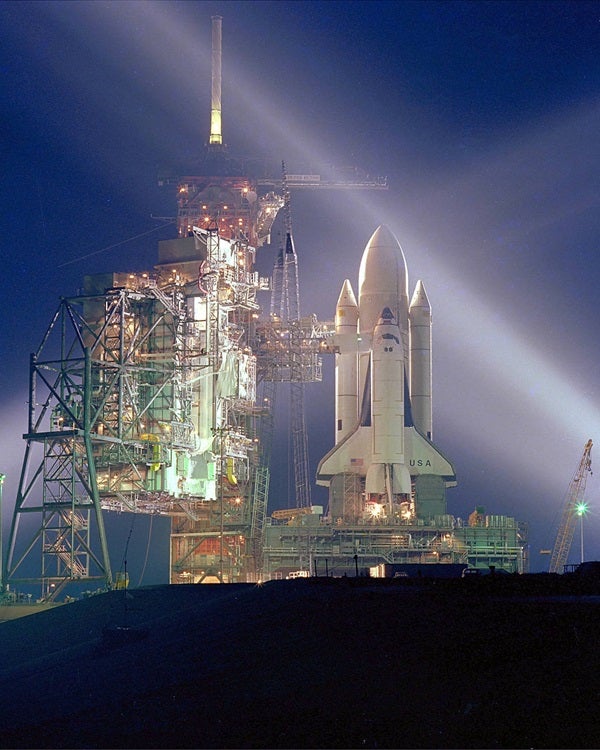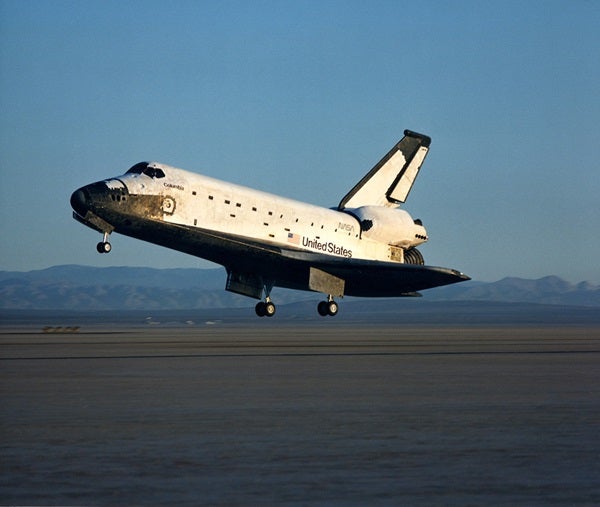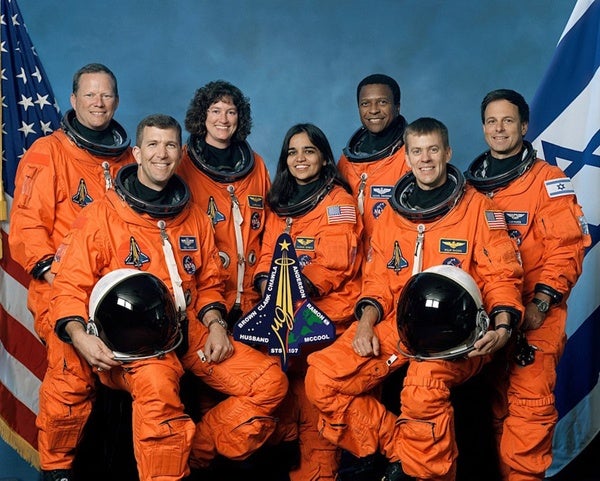Today marks the 37th anniversary of a launch that forever changed space travel. On April 12, 1981, the space shuttle Columbia successfully launched from NASA’s Kennedy Space Center and became the first reusable spacecraft to orbit Earth. The famous shuttle not only laid the groundwork for the success of NASA’s 30-year-long Space Shuttle Program, but also conducted invaluable space-based research during its 22-year journey.
The first-of-its-kind space flight was commanded by John Young, an astronaut whose experience included four previous trips to space and a walk on the Moon in 1972, and piloted by Robert Crippen, who went on to command three future space shuttle missions. The duo spent 54 hours piloting the craft, completing 36 orbits around Earth before successfully landing at Edwards Air Force Base in California on April 14. The achievement showed that the unconventional craft — a winged vessel that underwent a rocket-like launch and a glider-like landing — contained both groundbreaking design and high functionality. But it goes without saying that creating such a craft wasn’t a quick and easy task.
Construction on Columbia, which was named after the first U.S. ship to circle the globe, began at Rockwell International’s main assembly facility in Palmdale, California, in 1975. Its innovative design had begun as the Space Shuttle Program’s prototype Enterprise, which wasn’t able to conduct space missions due to its lack of engines and heat shields. After years of construction, Columbia was sent to the Kennedy Space Center on March 25, 1979, with a preliminary launch date planned for late 1979. However, due to issues with its thermal protection system and main engines, the launch was delayed for nearly a year and a half. By the time April 1981 arrived, the craft was issue-free and ready for liftoff. Columbia launched into orbit on April 12, 1981 — exactly 20 years after Yuri Gagarin became the first human to orbit Earth.
Columbia went on to complete three more proof-of-concept missions in 1981 and 1982 to ensure shuttle performance, reusability, and firmly establish its ability to launch and land safely. After successful demonstration, the craft embarked on its first operational mission November 11, 1982, where it deployed two commercial communication satellites into geosynchronous orbit. After this mission, Columbia remained Earth-bound for about a year to complete the construction of Spacelab — a reusable science lab designed to conduct space-based experiments. The first mission equipped with Spacelab launched November 28, 1983, with NASA and European Space Agency astronauts teaming up for their first dual shuttle mission. Together, they conducted 73 investigations involving atmospheric science, observations of Earth, astronomy, physics, and more on this single flight alone.
Its next two years were spent undergoing modifications while the Challenger, Discovery, and Atlantis spacecraft conducted missions and research. Columbia made its return to space January 12, 1986, for a six-day mission that intended to photograph Halley’s Comet from space with a 35mm camera, but issues with the camera’s batteries doomed the project. However, the crew moved forward with their other planned experiments, including creating the first space-grown protein crystals. The crystals’ purity turned out to be far superior to proteins on Earth, which allowed researchers to get a clearer, more in-depth look at their structure. The mission also carried out numerous experiments on the human body’s reaction to microgravity, including the Initial Blood Storage Experiment, which showed that blood platelets stored at microgravity retain more structural and functional integrity than those stored on Earth.
Unfortunately, the following mission in NASA’s Space Shuttle Program ended in tragedy. On January 28, 1986, structural malfunctions and cold temperatures at the Kennedy Space Center caused the Challenger space shuttle to explode only 73 seconds after liftoff, killing all seven crewmembers. The catastrophic event prompted NASA to suspend all space shuttle flights until September 1988.
Columbia returned to flight August 8, 1989, and proceeded to spend over a decade conducting space-based scientific research. Although the International Space Station was being constructed at the time, the Atlantis, Discovery, and Endeavor spacecraft were responsible for its assembly, and Columbia never made a trip to the station. The shuttle used Spacelab to host missions devoted to studying how humans, animals, and cells react to microgravity and how they acclimate to Earth’s gravity when they return to the ground. These experiments studied how the heart, muscles, bones, and various organs respond to periods in space, giving NASA the data needed to ensure astronauts’ health and wellbeing.
The craft also carried out technical missions, including the Robotics Experiment (ROTEX) in 1993, where a robotic arm, remotely controlled from Earth, successfully captured roaming space objects. Columbia also performed maintenance and repairs on satellites and the Hubble Space Telescope. On a repair mission in March 2002, crewmembers replaced Hubble’s Power Control Unit and solar array panels, installed the Advanced Camera for Surveys, and installed a cooling system for its Near-Infrared Camera and Multi-Object Spectrometer.
On January 16, 2003, Columbia set off on its 28th mission, STS-107. Some of the many studies scheduled for the mission included microgravity experiments, exploring different ways of encapsulating anti-cancer drugs, and testing a water recycling device before its installation on the International Space Station.
Unfortunately, complications during launch sealed its tragic fate. About 80 seconds after the shuttle launched from Kennedy Space Center, a suitcase-sized piece of foam insulation split off from the bipod ramp, which attached the external tank to the shuttle. The foam hit the shuttle’s left wing as it fell, and ground workers weren’t able to see the exact location or extent of the damage. NASA engineers concluded that if severe damage had occurred, the crewmembers wouldn’t be able to repair the shuttle while it was in orbit.
The mission was descending back to Earth February 1, 2003, when Mission Control began receiving strange signals from the left wing’s tire pressure and temperature sensors. They tried contacting the crew to address the problem, but lost communication. Shortly after, civilians began reporting debris falling from the sky. An investigation later determined that the foam shed during the launch created a hole in Columbia’s left wing, causing considerable damage to the shuttle’s sensors and allowing atmospheric gas to seep into the cabin during de-orbit. This resulted in the craft losing control and disintegrating as it re-entered Earth’s atmosphere. All seven crewmembers died.
Although Columbia’s extraordinary legacy ended in tragedy, we must remember to celebrate its remarkable accomplishments while mourning its loss. Over the course of its 22-year career, Columbia carried out 28 missions, logging 300.74 days in space, 4,808 orbits, and 125,204,911 miles flown. The craft, and all of the crewmembers responsible for its success, will be remembered for their irreplaceable contributions to space exploration. Without the Columbia missions and NASA’s Space Shuttle Program, space science might not be where it is today.












